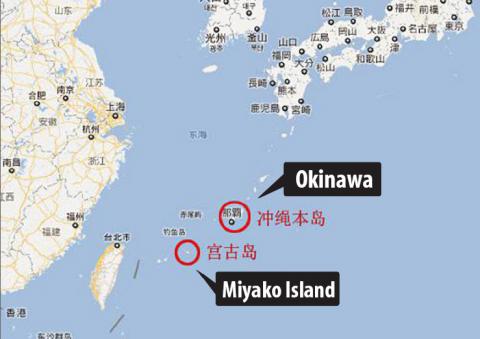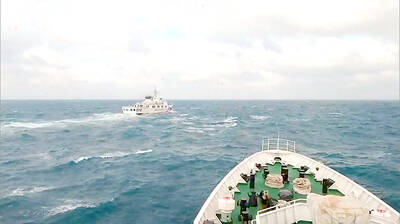Sorties by the Chinese navy into the Pacific Ocean are becoming more commonplace and provide it with the means to familiarize itself with the environment surrounding Taiwan, while creating a new front from which to attack in case of conflict, an analyst said.
Four frigates from the People’s Liberation Army Navy (PLAN) were spotted in waters between Miyako Island and Okinawa Island on Friday, the Japanese Ministry of Defense said last week. All four ships, which were tracked by a P-3C patrol aircraft deployed by the Japan Maritime Self-Defense Forces, were traveling from the direction of the East China Sea toward the Pacific Ocean, where they conducted exercises.
The ships — the Type 054A Jiangkai II-class missile frigate Changzhou, the Jiangwei II-class Jiangxing and Lianyungang and the Jiangwei I-class Tongling — stayed in international waters and did not enter Japanese territorial waters, the ministry said.

Source: screengrab from Google Map
All the ships, which are part of China’s East Sea Fleet, are equipped with anti-ship and surface-to-air missiles.
The 300km-wide channel between Okinawa and Miyako, known as the Miyako Strait, is regarded as one of the most convenient routes for Chinese vessels heading for the Pacific. Chinese vessels went through it in June 2010 and twice last year as they headed for exercises in the Pacific.
Such sorties have become increasingly commonplace as China’s navy gets more comfortable as an oceangoing navy, James Holmes, an associate professor at the US Naval War College, told the Taipei Times.
Holmes, who recently co-authored a study of the Chinese navy, said the Japanese Defense Ministry was now publishing maps of Chinese naval forays through the Japanese archipelago.
“The maps depict the tracks of PLAN flotillas as though ramen noodles were spilling through the home islands into the Pacific,” he said, adding that in peacetime, China had as much a right as anyone to transit through those waterways, provided they conformed to the restrictions in the Law of the Sea Treaty.
However, asked to discuss the implications for Taiwan’s security, Holmes was less sanguine.
“I have no doubt that the PLAN is familiarizing itself with the operating environment off Taiwan, including the coastal geography and underwater hydrography, and experimenting with tactics for waging war there,” he said.
“Some strategists, myself included, portray [Taiwan’s] rugged eastern coast as a kind of sanctuary for small missile boats and, potentially, submarines,” Holmes said. “It only makes sense for the PLAN to take the measure of the ‘strength and situation’ of a potential enemy before an armed clash.”
Crucially, the PLAN presence in the Pacific enhances its ability to fight all around Taiwan and not just along the west coast, which has been the traditional direction from which a Chinese attack would come, he said.
Miyako is located about 350km east off the northern tip of Taiwan, including Keelung Naval Base. The area also faces Cha Shan Air Base in Hualien.
Such encirclement of Taiwan would greatly complicate its ability to counter a naval attack and could exploit weaknesses in defenses along its east coast, which faces away from China.
“Equally important, by displaying that capability vis-a-vis Taipei and Washington, the navy enhances Beijing’s bargaining power in future dealings across the strait,” Holmes said. The PLA Navy is practicing the skills needed to coerce and deter while helping underwrite Chinese diplomacy in the bargain.”
In related developments, the People’s Liberation Army Daily announced on Tuesday that the recently commissioned Type 071 Jinggangshan landing platform dock under the South China Sea Fleet had conducted its first joint training with helicopters and air cushion boats. At 19,000 tonnes, the Jinggangshan is the heaviest LPD in the PLAN.

Auckland rang in 2026 with a downtown fireworks display launched from New Zealand’s tallest structure, Sky Tower, making it the first major city to greet the new year at a celebration dampened by rain, while crowds in Taipei braved the elements to watch Taipei 101’s display. South Pacific countries are the first to bid farewell to 2025. Clocks struck midnight in Auckland, with a population of 1.7 million, 18 hours before the famous ball was to drop in New York’s Times Square. The five-minute display involved 3,500 fireworks launched from the 240m Sky Tower. Smaller community events were canceled across New Zealand’s

The Ministry of Foreign Affairs (MOFA) yesterday said it is closely monitoring developments in Venezuela, and would continue to cooperate with democratic allies and work together for regional and global security, stability, and prosperity. The remarks came after the US on Saturday launched a series of airstrikes in Venezuela and kidnapped Venezuelan President Nicolas Maduro, who was later flown to New York along with his wife. The pair face US charges related to drug trafficking and alleged cooperation with gangs designated as terrorist organizations. Maduro has denied the allegations. The ministry said that it is closely monitoring the political and economic situation

‘SLICING METHOD’: In the event of a blockade, the China Coast Guard would intercept Taiwanese ships while its navy would seek to deter foreign intervention China’s military drills around Taiwan this week signaled potential strategies to cut the nation off from energy supplies and foreign military assistance, a US think tank report said. The Chinese People’s Liberation Army (PLA) conducted what it called “Justice Mission 2025” exercises from Monday to Tuesday in five maritime zones and airspace around Taiwan, calling them a warning to “Taiwanese independence” forces. In a report released on Wednesday, the Institute for the Study of War said the exercises effectively simulated blocking shipping routes to major port cities, including Kaohsiung, Keelung and Hualien. Taiwan would be highly vulnerable under such a blockade, because it

UNRELENTING: China attempted cyberattacks on Taiwan’s critical infrastructure 2.63 million times per day last year, up from 1.23 million in 2023, the NSB said China’s cyberarmy has long engaged in cyberattacks against Taiwan’s critical infrastructure, employing diverse and evolving tactics, the National Security Bureau (NSB) said yesterday, adding that cyberattacks on critical energy infrastructure last year increased 10-fold compared with the previous year. The NSB yesterday released a report titled Analysis on China’s Cyber Threats to Taiwan’s Critical Infrastructure in 2025, outlining the number of cyberattacks, major tactics and hacker groups. Taiwan’s national intelligence community identified a large number of cybersecurity incidents last year, the bureau said in a statement. China’s cyberarmy last year launched an average of 2.63 million intrusion attempts per day targeting Taiwan’s critical